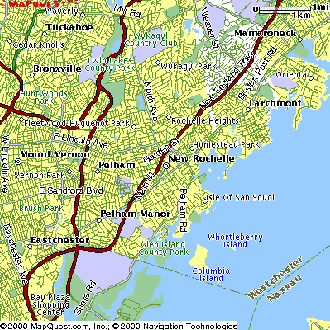|
history of New Rochelle |
|
The City of New Rochelle, one of New York State's oldest communities, is located in Westchester County, New York, on Long Island Sound. With its southern border less than one mile from the borough of the Bronx, and with Manhattan's Grand Central Terminal only a 35-minute train ride away, New Rochelle has been a commuter haven for more than a century. Unlike other well-known New York bedroom communities such as Scarsdale, Pelham, and Larchmont, all of which border New Rochelle, the city is economically and ethnically diverse and decidedly urban, enjoying many historic and cultural resources, but also facing challenges common to many older Northeastern cities.
New Rochelle's history begins with Thomas Pell's purchase of the Pelham Manor tract, of which the city would become part, from the Siwanoy Indians in 1654. Thirty-four years later, thousands of Huguenots - French Protestants who left France following Louis XIV's revocation of the Edict of Nantes, which had protected them from religious persecution - began settling the area. Their new home was named after La Rochelle, the port from which they had departed France. Through the 18th century, New Rochelle, with a 1790 population of 692 residents, remained a modest village. It retained an abundance of agricultural land, 300 acres of which was awarded in 1784 to the patriot Thomas Paine by New York State for his service to the cause of independence. In the first years of the 19th century, New Rochelle's industrialization and urbanization began in earnest. A four-story flourmill, said to be the country's largest at the time, was constructed in 1801; the next year, a tollhouse was built on the Westchester Turnpike (now Main Street), and the thoroughfare became the village's commercial heart, home to a concentration of taverns, stores, and homes. New Rochelle's urbanization accelerated following the 1848 completion of the New York and New Haven Railroad, which, today known as Metro-North's New Haven line, still connects New Rochelle with both cities and is a vital commuter link. By 1857, the population of the Town of New Rochelle approached 3,000. The growth and increasing complexity of New Rochelle in the late 19th century expressed itself in the establishment of a number of important institutions. The city's first significant newspaper, the Pioneer, began publication in 1860; the next year its first volunteer fire company was formed. New Rochelle's easy accessibility to New York City by steamboat led to the 1879 creation of the Glen Island fun park, which featured a zoo, natural history museum, bathing beach, Chinese pagoda, and German beer garden. The city board of health was created in 1881 in response to a smallpox epidemic, and horse car lines were established in 1886, improving transportation within the city. The New Rochelle Public Library was established in 1892. The 1890s saw intense development. During the decade, New Rochelle's population increased from 9,057 residents to 14,720. Perhaps more significantly, during the first decade of the 20th century, New Rochelle blossomed as a suburb. In 1902, Beechmont Lake was developed as the focal point of an attractive residential area; four years later, New Rochelle's advantages as a commuter haven were advertised to thousands through "Forty-five Minutes from Broadway," a George M. Cohan show in which it was featured. The city, which retained its reputation as an up-and-coming suburb for decades, is still remembered by many across the country as the sitcom home of the star of the "Dick Van Dyke Show" and his TV wife, played by Mary Tyler Moore, from 1961 to 1966. Today, New Rochelle remains the home of well-known artists and performers including Andrea McArdle, Ossie Davis and Ruby Dee, and Robert Merrill. The 1920s were, as much as any time, New Rochelle's glory years, with intense growth encouraging a sky's-the-limit attitude among its boosters and city fathers. In 1929, just before the notorious stock market crash, the Planning Board wrote in its City Plan and Twenty-Year Program of Public Improvements for New Rochelle, "We are strongly impressed with the fact that New Rochelle is at a critical point in its history. It clearly appears to be on the eve of a new and great development. It is nearer to New York City than any other community in which there is still available a large area suitable for the development of residential districts of a high type." New Rochelle had problems, but they were the kind that were nice to have: with a vibrant downtown full of entertainment and shopping opportunities, planners had to wrestle with a severe parking shortage; with "the market for apartment houses ¡¦ increasing," the planning board had to struggle with the question, "should apartment houses be encouraged or discouraged in a suburban city?" (They concluded, "the apartment house and the dwelling both have a place.") New Rochelle expected the good times to continue to roll. Its planners, projecting growth to 75,000 by 1940 and 90,000 by 1950, pointed to the city's "good shops and stores ¡¦ good harbor, and ¡¦ good railway freight facilities," figuring that "if anything, the prognostication for ¡¦ growth is most conservative. A population of 100,000 by 1950 is not at all impossible." In 1930, New Rochelle had 54,000 residents, who, in the early years of the 1930s, had the highest per capita income of any city residents in New York State. New Rochelle never reached
the magical 100,000 figure. In the 1980s, in the midst of healthy
suburban growth county- and nation-wide, New Rochelle's population
fell to 67,265, from 70,794 in 1980. |
|
